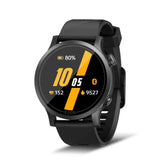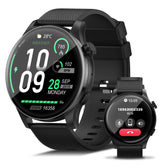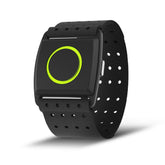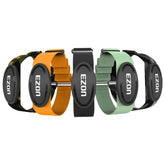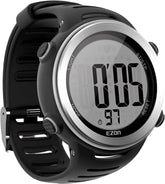すべての人のためのフィットネストラッキング: 男性、女性、さまざまな目標に合わせたカスタマイズ
フィットネスの世界では、すべての人に当てはまるものは存在しません。男性と女性の生理的差異やさまざまなフィットネス目標により、フィットネス トラッキングには個別のアプローチが必要です。高度なテクノロジーの登場により、フィットネス トラッカー ウォッチはこうした多様なニーズに対応できるようになり、個人が独自のフィットネス目標を効果的に設定して達成できるように支援します。この記事では、フィットネス トラッキングを男性と女性向けにカスタマイズする方法を探り、トラッキング テクノロジーを活用して最適な結果を得る方法について説明します。
性別によるフィットネスニーズを理解する
1. 生理学的差異
男性と女性には、フィットネスの過程に影響を与える異なる生理学的特徴があります。
-
体組成: 男性は一般的に女性に比べて筋肉量の割合が高く、その結果、代謝も一般的に高くなります。つまり、男性は筋力トレーニング中にカロリーをより早く燃焼できるのに対し、女性は脂肪の減少と筋肉の緊張のために別の戦略に重点を置く必要があるかもしれません。
-
ホルモンの違い: ホルモンはエネルギー レベル、気分、パフォーマンスに重要な役割を果たします。たとえば、女性は月経周期を通じてホルモンの変動を経験し、それがエネルギーとパフォーマンスに影響を与える可能性があるため、それに応じてトレーニングを追跡して調整することが不可欠です。
2. フィットネス目標
男性と女性ではフィットネスの目標が異なる場合があります。
-
男性: 一般的な目標には、筋肉量の増加、筋力の増強、運動能力の向上などがあります。フィットネストラッカーは、男性が進捗状況を監視し、持ち上げた重量を追跡し、筋肉増強のためのトレーニングを最適化するのに役立ちます。
-
女性: 女性は、減量、体を引き締め、全体的な健康を優先する場合があります。女性向けに設計されたフィットネストラッカーには、カロリー追跡、歩数計、心拍数モニタリングなど、ワークアウトを効果的に管理するのに役立つこれらの目標をサポートする機能が搭載されていることがよくあります。
男性と女性向けのフィットネストラッカーのカスタマイズ
1. 女性用フィットネストラッカーウォッチ
女性向けのフィットネストラッカーウォッチを選択するときは、女性特有のニーズに応える機能を考慮してください。
-
周期追跡: 多くの女性向けフィットネストラッカーには月経周期追跡機能が含まれており、ユーザーは症状を記録して周期を予測できるため、トレーニングの強度や回復を調整するのに役立ちます。
-
栄養とカロリーの必要量: 活動レベルと目標に基づいて、パーソナライズされた栄養情報を提供するトラッカーを探してください。この機能は、女性がフィットネス ルーチンを補完するために情報に基づいた食事の選択を行うのに役立ちます。
-
ストレスと回復のモニタリング: ストレス追跡機能は、心拍数の変動をモニタリングし、回復戦略を提案することで、女性が全体的な健康状態を管理するのに役立ちます。
2. 男性用フィットネストラッカーウォッチ
男性の場合、男性用フィットネストラッカーウォッチはパフォーマンスと強度に重点を置く必要があります。
-
筋力トレーニングの指標: セット数、反復回数、持ち上げた重量など、特定の筋力トレーニングの指標を追跡するデバイスを選択します。このデータは、男性が筋肉の成長と筋力の増強のためにトレーニングを最適化するのに役立ちます。
-
高度なパフォーマンス メトリック: VO2 最大値、回復時間、トレーニングの強度に関する情報を提供するトラッカーを探してください。これらの機能は、パフォーマンスの向上を目指すアスリートにとって貴重です。
-
GPS とアウトドア機能: 屋外でのアクティビティを優先する場合は、ランニング、サイクリング ルート、その他の屋外でのトレーニングを追跡できる GPS 機能付きの時計を検討してください。
3. フィットネスに最適なスマートウォッチ
フィットネスに最適なスマートウォッチは、性別に関係なく、さまざまなフィットネス レベルと目標に対応するさまざまな機能を備えている必要があります。注目すべき主な機能は次のとおりです。
-
心拍数モニタリング: 継続的な心拍数追跡により、ユーザーはトレーニング中に最適な心拍数ゾーンを維持できます。
-
アクティビティ追跡: 歩数、距離、消費カロリーなどの包括的なアクティビティ追跡により、毎日のアクティビティを総合的に把握できます。
-
カスタマイズ: パーソナライズされた目標とリマインダーを設定できる機能は、ユーザーのモチベーションと責任感を維持するのに役立ちます。
4. ウェアラブルスマートウォッチ
ウェアラブル スマートウォッチは、その多機能性から人気が高まっています。これらのデバイスは、多くの場合、フィットネス トラッキングと、通知、音楽コントロール、非接触型決済などのスマート機能を組み合わせています。特にアウトドア愛好家の場合は、快適性と耐久性を重視したモデルを探してください。
フィットネス目標の設定と達成
1. 明確な目標を定める
具体的、測定可能、達成可能、関連性があり、期限が定められた (SMART) 目標を設定することで、フィットネスの旅を導くことができます。5 キロを走る、一定の体重を減らす、筋力を強化するなど、明確な目標を設定することで集中力を維持できます。
2. 追跡技術を活用する
フィットネストラッカーの機能を活用して、目標に向けた進捗状況を監視できます。データを定期的に確認することで、傾向を特定し、成果を祝い、必要に応じて計画を調整することができます。
3. 責任を果たす
フィットネス コミュニティに参加したり、フィットネス トラッカーのソーシャル機能を使用したりすることで、モチベーションと責任感が高まります。友人と進捗状況を共有したり、チャレンジに参加したりすることで、フィットネスへの取り組みを強化できます。
4. 調整と進化
進歩するにつれて、躊躇せずに目標を再評価し、トレーニング計画を調整してください。フィットネスは動的な旅であり、トラッカーは継続的な成功のためにアプローチを適応させるための貴重な洞察を提供します。
結論
フィットネス トラッキングは、男性と女性の独自のニーズに合わせてカスタマイズできる強力なツールです。生理的な違いを理解し、個別の目標を設定し、 女性用フィットネス トラッカー ウォッチ、 男性用フィットネス トラッカー ウォッチ、 フィットネスに最適なスマート ウォッチなどの適切なテクノロジーを活用することで、個人はワークアウトを最適化し、持続的な結果を達成できます。利用可能なテクノロジーを活用し、フィットネスの旅に全力で取り組み、パーソナライズされたフィットネス トラッキングの変革力をお楽しみください。
